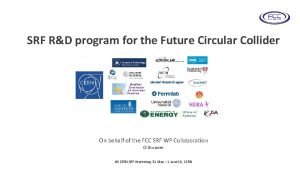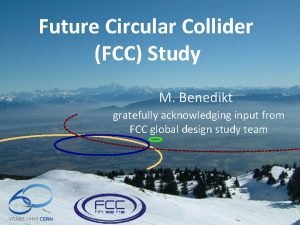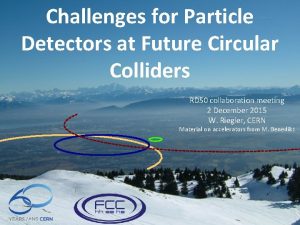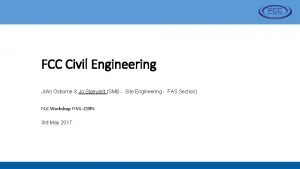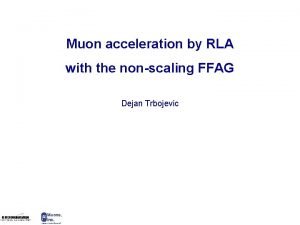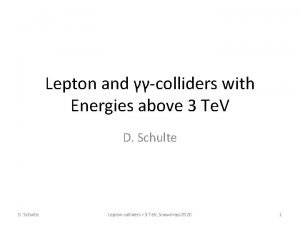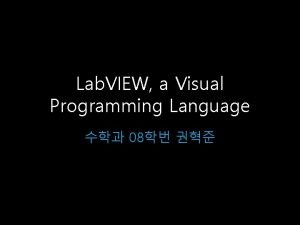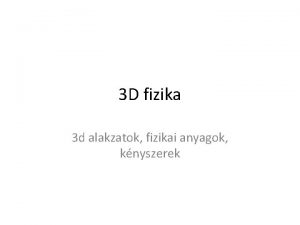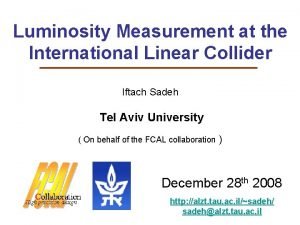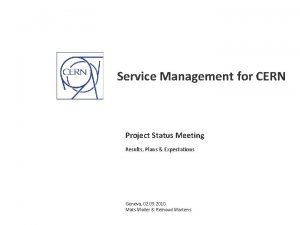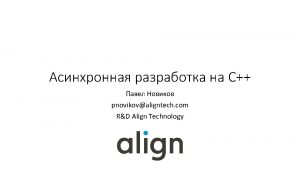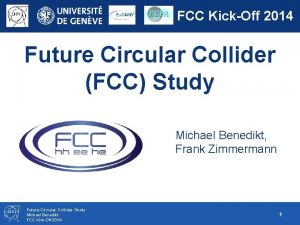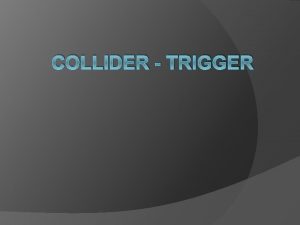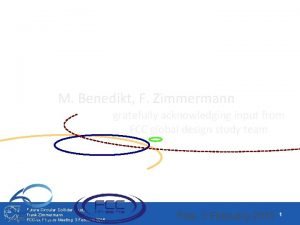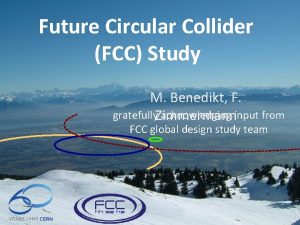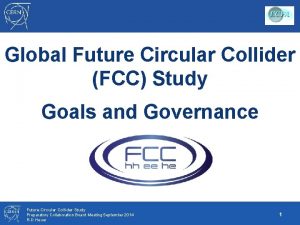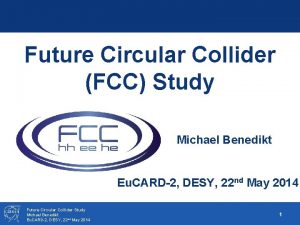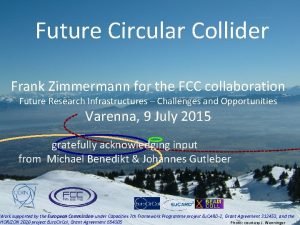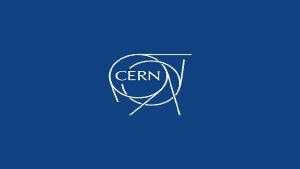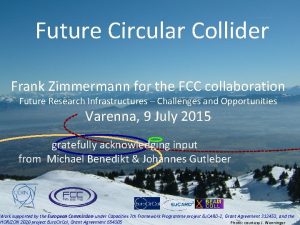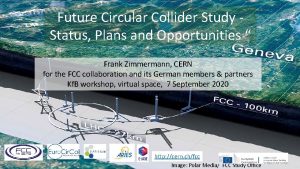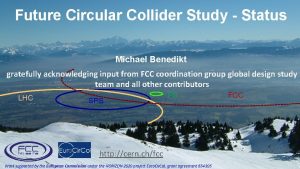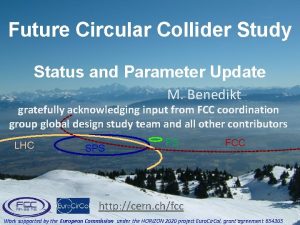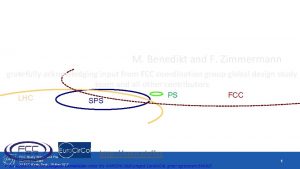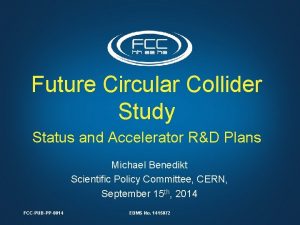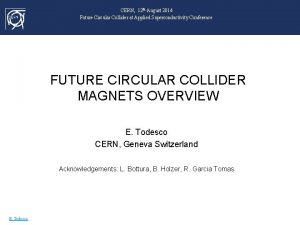Future Circular Collider FCC Study Status http cern



















- Slides: 19

Future Circular Collider (FCC) Study Status http: //cern. ch/fcc Michael Benedikt FCC Study – Overview and status Michael Benedikt 13. August 2014, ASC Charlotte 1

Outline • Motivation & scope • Parameters & design challenges • Study organization, study time line • Summary FCC Study – Overview and status Michael Benedikt 13. August 2014, ASC Charlotte 2

Summary: European Strategy Update 2013 Design studies and R&D at the energy frontier …. “to propose an ambitious post-LHC accelerator project at CERN by the time of the next Strategy update”: d) CERN should undertake design studies for accelerator projects in a global context, • with emphasis on proton-proton and electron-positron high-energy frontier machines. • These design studies should be coupled to a vigorous accelerator R&D programme, including high-field magnets and high-gradient accelerating structures, • in collaboration with national institutes, laboratories and universities worldwide. • http: //cds. cern. ch/record/1567258/files/esc-e-106. pdf FCC Study – Overview and status Michael Benedikt 13. August 2014, ASC Charlotte 3

Future Circular Collider Study - SCOPE CDR and cost review for the next ESU (2018) Forming an international collaboration to study: • pp-collider (FCC-hh) defining infrastructure requirements ~16 T 100 Te. V pp in 100 km ~20 T 100 Te. V pp in 80 km • e+e- collider (FCC-ee) as potential intermediate step • p-e (FCC-he) option • 80 -100 km infrastructure in Geneva area FCC Study – Overview and status Michael Benedikt 13. August 2014, ASC Charlotte

Goals CDR phase 2014 -2018 • Conceptual design report by end 2018 • • Parameter optimisation and baseline development Conceptual design of machines, experiments and infrastructure Launch R&D in SC magnet and SRF areas Identification of technical challenges and R&D needs and R&D planning Cost model and estimation, project schedule estimation Preparation and planning for a technical design phase (TDR phase) Preparation of global FCC collaboration FCC Study – Overview and status Michael Benedikt 13. August 2014, ASC Charlotte 5

Hadron collider FCC-hh parameters • • Energy Circumference Dipole field (top energy) Dipole field (injection) 100 Te. V c. m. ~ 100 km (base line) [80 km option] ~ 16 T (base line) [20 T option] ~ 1 T (base line) [1. 2 T option] • • Bunch spacing Bunch population (25 ns) #bunches Stored beam energy 25 ns [5 ns option] 1 x 1011 p 10500 8. 2 GJ/beam • • • Luminosity b* #IPs 5 x 1034 cm-2 s-1 1. 1 m [2 m conservative option] 2 main (tune shift) + 2 • • Synchroton radiation arc 26 W/m/aperture (filling fact. 78% in arc) Longit. emit damping time 0. 5 h FCC Study – Overview and status Michael Benedikt 13. August 2014, ASC Charlotte 6

FCC-hh: high-field magnet targets • FHC baseline is 16 T Nb 3 Sn technology for ~100 Te. V c. m. in ~100 km Develop Nb 3 Sn-based 16 T dipole technology (at 4. 2 K? ), - with sufficient aperture (40 – 50 mm) and - accelerator features (margin, field quality, protect-ability, cycled operation). - conductor developments Goal: 16 T short dipole models by 2018/19 (America, Asia, Europe) • • In parallel HTS development targeting 20 T. HTS insert, generating o(5 T) additional field (Eu. CARD 2), in an outsert of large aperture o(100 mm) (FRESCA 2 or other) Goal: Demonstrate HTS/LTS 20 T dipole technology in two steps: • a field record attempt to break the 20 T barrier (no aperture), and • a 5 T insert, with sufficient aperture (40 mm) and accelerator features FCC Study – Overview and status Michael Benedikt 13. August 2014, ASC Charlotte 7

FCC-hh: some other design challenges • Energy in beam & magnets, dump, collimation, quench protection • Stored beam energy and losses critical: 8 GJ/beam (0. 4 GJ LHC) Ø Collimation, losses, radiation effects are very important Ø Magnet and machine protection to be considered from early phase • High synchrotron radiation load on beam pipe (inside cold-mass) • Up to 26 W/m/aperture in arcs, total of ~5 MW for the collider • (LHC has a total of 1 W/m/aperture from different sources) • LHC-type beam screen • • Open midplane magnets • • Cooling efficiency depends on screen temperature, higher temperature larger impedance 40 -60 K? Synergies with muon collider developments Photon stops • dedicated warm photon stops for efficient cooling between dipoles, as developed by FNAL for VLHC http: //inspirehep. net/record/628096/files/fermilab-conf-03 -244. pdf Also P. Bauer et al. , "Report on the First Cryogenic Photon Stop Experiment, " FNAL TD-03 -021, May 2003 FCC Study – Overview and status Michael Benedikt 13. August 2014, ASC Charlotte 8

total cryo power for cooling of SR heat Ph. Lebrun D Schulte contributions: beam screen (BS) & cold bore (BS heat radiation) Optimum BS temperature range: 50 -100 K ; 40 -60 K favoured by impedance & vacuum considerations FCC Study – Overview and status Michael Benedikt 13. August 2014, ASC Charlotte 9

Lepton collider FCC-ee parameters • Design choice: max. synchrotron radiation power set to 50 MW/beam • Defines the max. beam current at each energy. • 4 Physics working points • Optimization at each energy (bunch number & current, emittance, etc). Parameter TLEP-Z TLEP-WW TLEP-H TLEP-ttbar LEP 2 45 80 120 175 104 I (m. A) 1450 152 30 6. 6 3 Bunches/beam 16700 4490 170 160 4 Bunch popul. [1011] 1. 8 0. 7 3. 7 0. 86 4. 2 L (1034 cm-2 s-1) 28. 0 12. 0 4. 5 1. 2 0. 012 E/beam (Ge. V) • For TLEP-H and TLEP-t the beam lifetime of ~few minutes is dominated by Beamstrahlung (momentum acceptance of 2%). FCC Study – Overview and status Michael Benedikt 13. August 2014, ASC Charlotte 10

FCC-ee: RF parameters and R&D FCC Study – Overview and status Michael Benedikt 13. August 2014, ASC Charlotte 11

Other SC magnet R&D for FCC • Nb 3 Sn quadrupoles for regular arc hadron collider • IR magnets and special magnets in collimation regions • in high radiation zones, larger aperture • • Transmission line magnet (injectors, TLs) • • SC cable in warm iron yoke (SF magnet), double aperture magnets Pulsed SC magnets (injectors, TLs) • • HTS SC cable in warm iron SC septum magnets for beam dumping (injection? ) • Beam losses, quench per design? • Current leads • Overall optimization of powering and energy distribution system FCC Study – Overview and status Michael Benedikt 13. August 2014, ASC Charlotte 12

FCC study status • Global collaboration based on general Mo. U between CERN and individual partners. • Addenda for each participant describing specific contributions and conditions. • Presently discussions with potential collaborators to conclude Mo. Us and establish collaboration. • First international collaboration board meeting on 9. and 10. September 2014 at CERN. FCC Study – Overview and status Michael Benedikt 13. August 2014, ASC Charlotte 13

EU H 2020 FCC Design Study proposal Focused on hadron collider design (main emphasis of study) HH Interaction region design HH Arc design HH Cryo-magnet-vacuum-beam pipe HH high-field magnet design Management, Coordination and Implementation FCC Study – Overview and status Michael Benedikt 13. August 2014, ASC Charlotte Collider functional machine design Key technological aspects Coordination, CDR, Strategy, Cost 14

FCC work plan study phase 2014 Q 1 Q 2 Q 3 2015 Q 4 Q 1 Q 2 Q 3 2016 Q 4 Q 1 Kick-off, collaboration Prepar forming, e study plan and organisation Ph 1: Explore options “weak interaction” Q 2 2017 Q 3 Q 4 Q 1 Q 2 Q 3 2018 Q 4 Q 1 Q 2 Q 3 Q 4 Workshop & Review identification of baseline 2: Conceptual study Explore options, now – Ph spring 2015: of baseline “strong - Investigate different options in all technical areas, taking a broad view interact. ” Workshop & Review, cost - Deliverables: description and comparison of options with relative merits/cost, model, LHC results study re- Develop schedules, understand relative impact of options on overall scoping? Ph 3: Study time, etc. ) schedule (physics operation time, machine installation - FCC workshop to converge to common baseline consolidation with small number of options Workshop & Proposed WS date 23 – 27 March 2015 (presently no known collisions…) 4 large FCC Workshops Review Followed by review ~2 months later, begin June 2015 distributed over participating regions FCC Study – Overview and status Michael Benedikt 13. August 2014, ASC Charlotte contents of CDR Report Release CDR & Workshop on next steps 15

ESU today FCC study milestones CDR and Cost Review 2018 Project Kick-off meeting: 11 th Nov. 2013 (Daresbury) FCC Kick-off meeting February 2014 12 th-14 th Study CDR and Cost Review for 2018 FCC Study – Overview and status Michael Benedikt 13. August 2014, ASC Charlotte 16

Conclusions • There are strongly rising activities in energy-frontier circular colliders worldwide. CERN is setting-up an international study for the design of Future Circular Colliders (FCC). • Worldwide collaboration in physics, experiments and accelerators will be essential to advance and reach the goal of a CDR by 2018. • FCC presents challenging R&D requirements for SC magnets in many different areas: • Main focus is the 16 T Nb 3 Sn program as hadron collider baseline, representing a natural continuation of HL-LHC developments • HTS for special magnets and as option to the 16 T program • SF and pulsed SC magnets as potential options for injectors, TLs. • SC septum magnets • HTS current leads for power distribution systems. Need your collaboration and use all synergies to move forward! FCC Study – Overview and status Michael Benedikt 13. August 2014, ASC Charlotte 17

Work and organisation status (i) Work/meeting structures established based on INDICO, see: - FCC Study: https: //indico. cern. ch/category/5153/ - FCC-hh Hadron Collider VIDYO meetings - https: //indico. cern. ch/category/5263/ - Contacts: daniel. schulte@cern. ch - FCC-hadron injector meetings - https: //indico. cern. ch/category/5262/ - Contacts: brennan. goddard@cern. ch - FCC-ee (TLEP) Lepton Collider VIDYO meetings - https: //indico. cern. ch/category/5264/ - Contacts: jorg. wenninger@cern. ch, FCC Study – Overview and status Michael Benedikt 13. August 2014, ASC Charlotte 18

Work and organisation status (ii) - FCC infrastructure meetings - https: //indico. cern. ch/category/5253/ - Contacts: philippe. lebrun@cern. ch, peter. sollander@cern. ch - FCC-hh Hadron Collider Physics and Experiments VIDYO meetings - https: //indico. cern. ch/category/5258/ - Contacts: michelangelo. mangano@cern. ch, fabiola. gianotti@cern. ch, austin. ball@cern. ch - FCC-ee Lepton Collider (TLEP) Physics and Experiments VIDYO meetings - https: //indico. cern. ch/category/5259/ - Contacts: alain. blondel@cern. ch, patrick. janot@cern. ch FCC Study – Overview and status Michael Benedikt 13. August 2014, ASC Charlotte 19
 Fcc-ee
Fcc-ee Fcc collider
Fcc collider Fcc collider
Fcc collider Fcc cern
Fcc cern Example of future perfect continuous tense
Example of future perfect continuous tense Future perfect simple and future continuous exercises
Future perfect simple and future continuous exercises Muon collider
Muon collider Muon collider
Muon collider Visual basic programming language
Visual basic programming language Unity sphere collider
Unity sphere collider Hadron collider
Hadron collider Hadron collider
Hadron collider International linear collider
International linear collider Cern service now
Cern service now Design elements hair
Design elements hair Std::async
Std::async Http //mbs.meb.gov.tr/ http //www.alantercihleri.com
Http //mbs.meb.gov.tr/ http //www.alantercihleri.com Http //pelatihan tik.ung.ac.id
Http //pelatihan tik.ung.ac.id Future perfect
Future perfect What is use in past tense
What is use in past tense
